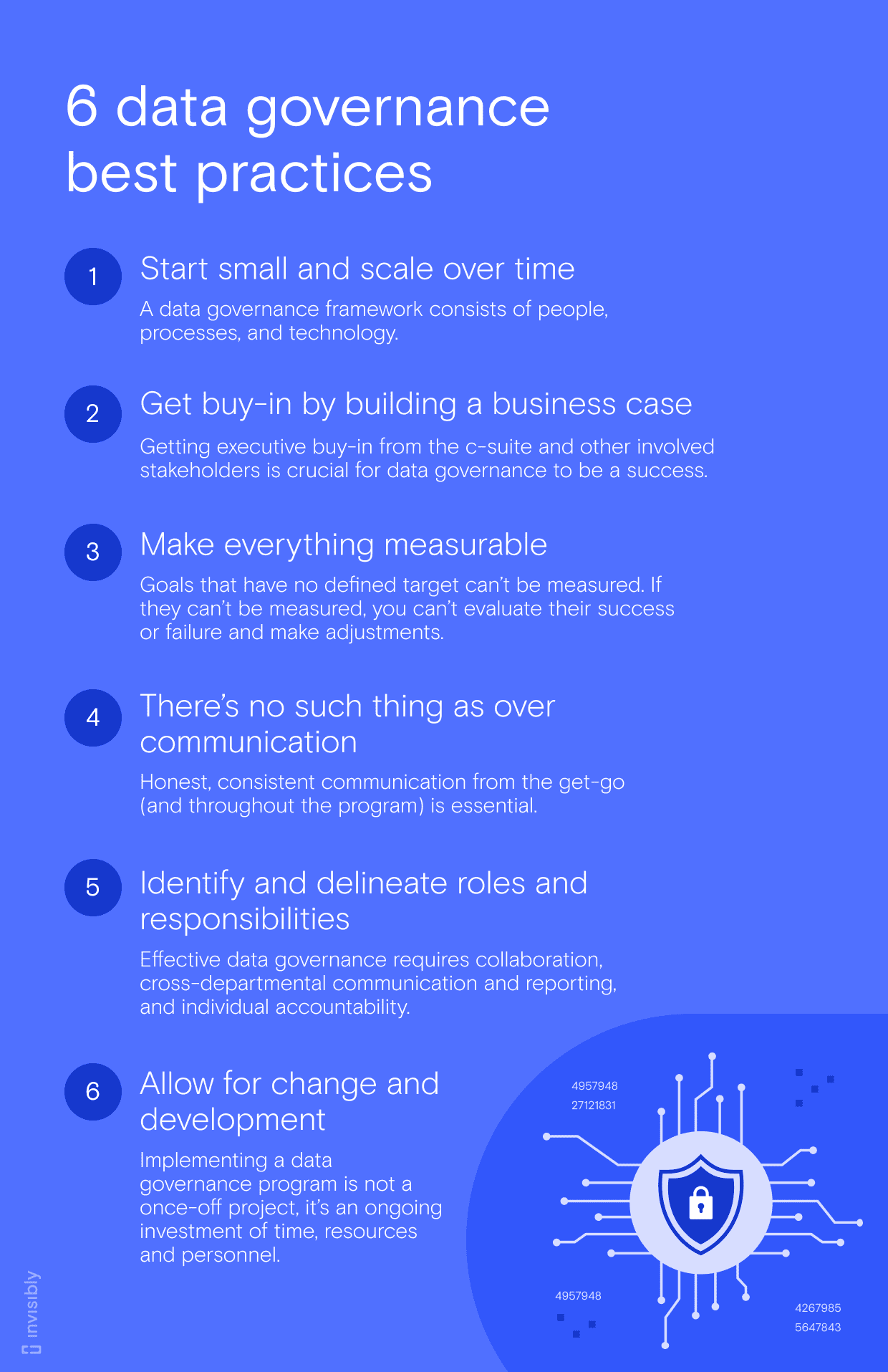Why is data governance important?
Data governance is important because it protects data assets from potential theft, security breaches, misuse, and loss – all of which could impact a business’s long-term operability.
As an organization working in a digital environment, you’re likely working with dozens, if not hundreds, of data sources, with data flowing freely across the company. When working with so much data, the most important questions to be asking are: Where is this data stored and who can view and access it? How does data move throughout the organization? How do you safeguard data security while preserving data quality and preventing siloes from forming?
Data governance aims to answer these questions and more with practical, scalable solutions. The goals of effective data governance are:
- minimizing risks associated with data collection, storage, and use.
- Setting rules and compliance procedures for internal data usage.
- Meeting ongoing and evolving data compliance policies and regulations.
- Increasing data value through more focused, streamlined application and use.
- Facilitating the rollout and implementation of these processes across all departments.
- Continuously evaluating the efficacy and success of these goals against predefined metrics.
A data governance framework consists of the people, processes and technologies required to meet these goals.
Is data governance the same as data management?
Data governance is not the same thing as data management. Data management revolves around the processes and tools that create, collect, store, retrieve, control, and destroy data, while data governance focuses on the responsibilities and processes for data protection, access, ownership, and use. Data governance is a subset of data management.
The key principles of good data governance
The Data Governance Institute reports that there are eight principles that underpin all good data governance strategies.
1. Integrity
Everyone participating in data governance practices, whether they’re setting the regulations, monitoring them, or simply utilizing them in daily operations need to have integrity. All participants must be honest and forthcoming about any actions, strategies, constraints, or problems around data-related governance decisions.
2. Transparency
All data governance processes introduced require complete transparency. Participants are more likely to accept and adopt new processes when they understand its purpose, benefit, and greater value to the organization, as well as how it will be implemented, monitored, and measured.
3. Traceability
All new and existing data governance decisions, procedures, and strategies must be auditable. Every process should be traceable through proper documentation and recordings for future reference and evaluation.
4. Accountability
There must be clear accountability for everyone participating in data governance regarding roles, responsibilities, expectations, and performance. This includes the Data Governance Board, data managers, data owners, data stewards and data users.
5. Authority
In addition to accountability, a data governance strategy must clearly delineate final authority and responsibility. Every participant must know who has final authority over stewardship activities from individual and group data stewards in relation to the larger network of authority and management.
6. Collaboration
All parties need to understand collaboration requirements that enable necessary checks and balances between different teams, particularly governance teams that use data, teams that manage it, and teams that are responsible for compliance and regulation of data governance practices.
7. Standardization
Good data governance is built on standardization of all procedures and practices and adherence to this standardization at all levels and across all organizational verticals, to prevent visibility gaps, transparency breakdowns, and errors that could result in costly losses.
8. Change
Data governance is not a short-term project, it’s an ongoing investment that will evolve over time in accordance with business needs and data management practices. Therefore, data governance must allow room for proactive and reactive change management activities and avoid leaning too heavily on legacy structures and strategies.
Six data governance best practices

1. Start small and scale over time
As mentioned above, a data governance framework consists of people, processes, and technology. It might be tempting to give in to “big picture” thinking and try to create everything at once, but this can quickly lead to problems, errors, and oversights. Keep the big picture in mind but start small and implement a brick-by-brick approach to development.
Begin with hiring or identifying the right people in your organization who can work at building out the necessary processes for good data governance, and can then source the technology (like a data catalog and data lineage software) to facilitate these processes.
2. Get buy-in by building a business case
Getting executive buy-in from the c-suite and other involved stakeholders is crucial for data governance to be a success. This is generally not an easy feat, especially when presenting the initial and ongoing investment costs involved. The best way to win the buy-in you need is to build a strong business case for why the organization needs robust data governance.
You can build a strong business case by identifying and highlighting all of the benefits and opportunities that data governance will introduce to the organization. Efficiency gains, revenue increases, cost reductions, clawbacks, better business security, and an enhanced customer experience are all examples you can and should highlight when making the case for introducing an integrated data governance process. Helping executives to understand the “on the ground” value of good governance is key to winning buy-in.
3. Make everything measurable
Goals that have no defined target can’t be measured. If they can’t be measured, you can’t evaluate their success or failure and make adjustments. Make sure every process or larger strategy introduced has a defined, measurable goal or goals.
Consistently measure the outcomes of all processes and analyze the results to decide if they’re effective or need adjusting.This ties back to finding the right people. Working with people and teams who have the knowledge and expertise will make this ongoing exercise easier.
4. There’s no such thing as over communication
Honest, consistent communication from the get-go (and throughout the program) is essential. Share updates with all relevant stakeholders, record progress and changes, celebrate successes, and acknowledge errors and setbacks. Ensure all communications are easily accessible and shared with the right people to prevent knowledge gaps and communication breakdowns that could impact process results.
5. Identify and delineate roles and responsibilities
Effective data governance requires collaboration, cross-departmental communication and reporting, and individual accountability. Clearly defined roles with responsibilities and expectations listed are crucial to facilitating this. Without role clarity, there’s a risk of confusion regarding who is accountable for what and who has final authority over certain decisions and actions taken.
All of this can threaten governance success, so eliminate it by taking the time to identify and delegate roles, responsibilities, and hierarchy to your entire data governance team, to prevent confusion and friction.
6. Allow for change and development
Implementing a data governance program is not a once-off project, it’s an ongoing investment of time, resources and personnel. It’s a continuous process that will go through multiple iterations and evolve over time, growing from previous successes and failures, as well as evolving business needs.
This needs to be clearly communicated from the beginning to prevent misunderstandings and budget cuts. Remember to emphasize the long-term value that the program is bringing to the business.
You need to make room for inevitable changes and developments as they emerge in the program. They’re a necessary part of program improvement which directly affects results and objectives.
Invisibly is committed to adding value to the digital ecosystem
At Invisibly, we’re committed to building a more connected digital ecosystem through the ethical exchange of data. Invisibly connects businesses with the user data they’re looking for. Users who sign up actively share their consented data in exchange for access to premium brand rewards.
Partnering with Invisibly gives you access to a wider, more diverse net of user data that you can use to drive organizational growth and innovation.

Invisibly
See your data work for you.
